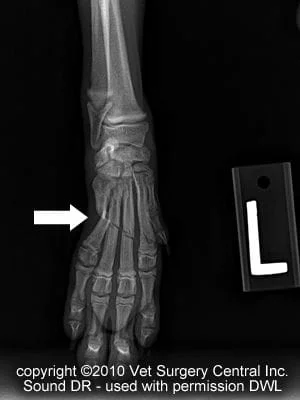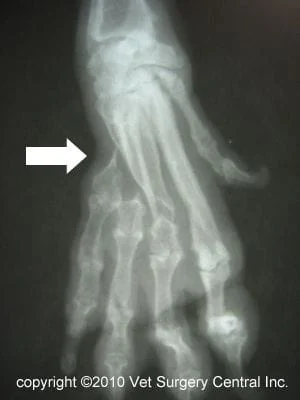Key Points
Fractures of the metatarsals or metacarpals can be managed with either splinting or surgery
Your pet’s surgeon will determine which treatment will be best
Most fractures of the paw heal uneventfully
Initial visit- downloadable forms/information for clients:
History sheet - Client initial consultation history
Client education handout - metabone fractures
Discharge instructions for postop care with cast/splint - dog
Discharge instructions for postop care with cast/splint - cat
2-week recheck visit - downloadable forms/information for clients:
History form - 2 week postop (Telemedicine evaluation) - dog and cat
Postop care instructions 2-week fracture repair recheck - cat
Postop care instructions 2-week fracture repair recheck - dog
8-week recheck visit - downloadable forms/information for clients:
History form 8-week fracture recheck (in hospital) - dog and cat
Postop care instructions 8 week fracture recheck - dog
Postop care instructions 8 week fracture recheck - cat
Anatomy
The paws have many small bones that are held in place by strong ligaments. There are four long bones of the hind and forelimb paws called the metatarsals and metacarpals, respectively.
Cause of fractures
The most common cause of metacarpal and metatarsal fractures include being stepped by a human, being hit by a car, getting the paw caught in a chain-linked fence or getting the paw caught in a hole in the ground when running. Sometimes the injury will result in an open wound over the fractures in which dirt and hair usually are driven into the tissues. This could potentially result in infection and delayed healing.
Signs and diagnosis
The clinical signs of a metacarpal or metatarsal fracture include nonweight-bearing lameness, swelling, and abnormal movement of the paw (instability). In order to diagnose a fracture, x-rays of the affected area are needed. Prior to anesthesia and surgery, blood work is done in order to evaluate the health of your companion’s internal organs.
Surgery
There are two treatment options for metacarpal and metatarsal fractures. Traditionally, surgery has been recommended to stabilize these fractures, however, based on one research study, surgery is not always needed. Surgery may be elected in select cases in which the bones are very displaced, the pet is older as healing may be slower, the fractures have occurred more than 3 to 4 days since injury and cannot be reduced and if the pet is a show dog and the final cosmetic and functional outcome is very important. Surgery involves realigning the fractured bones and securing them in place with plates and screws. Placing pins into the marrow cavity to repair fractured bones in the paw is another method of repair. Your companion’s surgeon will make a recommendation for the best treatment option for your companion, whether the fracture is supported with a cast alone or with surgical intervention and cast.


Here is an example of metacarpal fractures that were improperly managed with a splint. The owner did not return to the veterinarian for bandage changes, thus the fractures were unstable during the healing process. This x-ray was made 6 months after the fracture occurred and the outer two (metacarpals 4 and 5) did not heal at all and the dog was continually lame on the limb.
Aftercare
After surgery, you can continue to give your pet a prescribed pain reliever to minimize discomfort. A cast or splint is commonly placed on the limb for 5 to 8 weeks, until the healing is complete. The cast/splint will need to be changed every one to two weeks at our hospital until no external support is necessary. It’s also extremely important to limit your companion’s activity and exercise level during the post-operative period. Detailed instructions will be given to you after the surgery. The surgeon will monitor the healing process every 1 to 2 weeks, during each cast/splint change. During the final exam, at three to eight weeks after the surgery (depending on the age of the pet), x-rays will be made to evaluate the healing process.
Prognosis
Surgical repair of a fracture metacarpals or metatarsal with plates and screws allows for successful healing of the fractures bones. Casting is another good option that can be used in many cases. Occasionally, the fracture will fail to heal, resulting in a painful paw that prevents full use of the limb (see photo right). Uncommon complications following surgery include infection, failure of healing to take place, breakage of the metal plate or screws and cold sensitivity.




